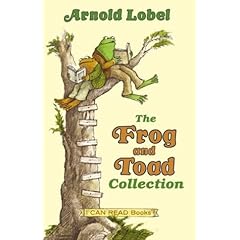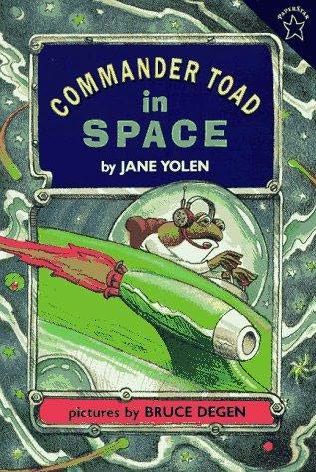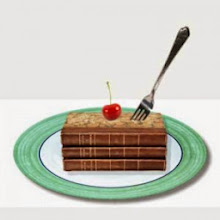Hard on the heels of Tasha's list yesterday, here's an article about the 35 best picture books of the year from the Children's Book Examiner.
I haven't read them all, but in the main I agree. What do you think? Agree? Disagree? Wailing loudly over the one that got left off?
Happy New Year! Be sure to kiss somebody at midnight, and if it's a frog, get an after picture.
Wednesday, December 31, 2008
Happy Cybils Eve!
Tomorrow, the finalists for the Cybils award will be announced. Huzzah! Huzzah! This means we only have a month and a half until the WINNAHS are announced on Valentine's Day, and I have a month and a half of poring over picture books and debating them with other people who love picture books. Can't think of anything I'm looking forward to more.
Also, there's some piffling thing about a New Year starting tomorrow. Feh. Clearly, people have their priorities all messed up.
See you back here tomorrow!
Also, there's some piffling thing about a New Year starting tomorrow. Feh. Clearly, people have their priorities all messed up.
See you back here tomorrow!
Tuesday, December 30, 2008
What Were Your Favorites?
Tasha Saecker over at Kids Lit has posted her favorite picture books of the year, broken down by month. My own list is coming soon (still agonizing over it, if you must know) but in the meantime, what were some of your faves this year?
Tuesday, December 23, 2008
Lio at the Library
I love Mark Tatulli's comic strip Lio, which features a kooky little kid. To give you an idea of the off-kilter tone of the comic strip, Lio sleeps with a stuffed bunny that has vampire fangs. Hee. This kid is right up my alley.
Plus, he seems to spend a lot of time in libraries. Check out this one from about ten days ago. It entertained me no end.
Plus, he seems to spend a lot of time in libraries. Check out this one from about ten days ago. It entertained me no end.
Thursday, December 18, 2008
Book Review: The House in the Night by Susan Marie Swanson
 I'm slowly getting settled into my new town and my new job. Hopefully I'll get back to a regular(ish) posting schedule next week. In the meantime, here's a book review for y'all.
I'm slowly getting settled into my new town and my new job. Hopefully I'll get back to a regular(ish) posting schedule next week. In the meantime, here's a book review for y'all.Book: The House in the Night
Author: Susan Marie Swanson
Illustrator: Beth Krommes
Published: 2008
This picture book follows a little girl through her evening as she settles down for bed and reads a book to herself--one that takes her to the stars and beyond before she slips off to sleep.
There's plenty of love for this one already, but I had to add my voice to the chorus. I fell in love with this book from the first page. I actually got a little sleepy reading it. Not because it’s boring or anything, but because the rhythm of the words and the mostly-cumulative structure just made it that perfect kind of soothing book that knocks Junior out every time. Kudos Susan Marie Swanson.
I often flip through picture books while sitting at the reference desk, but this one would not be flipped through. I had to check it out and take it home so I could pore over the illustrations--mostly black and white scratchboard, but with important things picked out in vivid marigold. As the child's imagination takes over, the marigold tones become more widespread, then subside as she falls asleep, only to return strongly on the very last page as she dreams. Kudos Beth Krommes.
Look for this one to join Goodnight Moon as a bedtime book Mom and Dad will have memorized in about a week.
Sunday, December 7, 2008
Readergirlz introduce Readertotz!
Poking my head out of the maze of packing boxes for a moment, I saw the news all over the kidlitosphere about Readergirlz' (is that the proper punctuation?) newest venture, Readertotz.
With a name like that, you expect this blog to skew younger than the YA goodness of Readergirlz. The cool thing is, it skews to the very youngest of all. From the press release:
I love board books, which seem to occupy a funny place in children's literature. We're just starting to realize the importance of exposing kids to books right from birth, so board books are more and more readily available. (I saw some at the dollar bins at Target the other day. Huzzah!) There's a lot that are just repackaged picture-book classics, with varying degrees of success. But the most successful ones, the ones destined to become classics in their board book form, are ones that are aimed directly at the infants and toddlers for whom the board-book format was invented.
I like Leslie Petricelli, Todd Parr, lift-the-flap, touch-and-feels, and so many more. I'll be following Readertotz for sure!
And now back to packing. Except I think I put my tape inside one of these boxes. Uh-oh.
With a name like that, you expect this blog to skew younger than the YA goodness of Readergirlz. The cool thing is, it skews to the very youngest of all. From the press release:
a unique board book blog that aims to raise awareness of the infant-toddler book as a significant format of children’s literature.Zowie.
I love board books, which seem to occupy a funny place in children's literature. We're just starting to realize the importance of exposing kids to books right from birth, so board books are more and more readily available. (I saw some at the dollar bins at Target the other day. Huzzah!) There's a lot that are just repackaged picture-book classics, with varying degrees of success. But the most successful ones, the ones destined to become classics in their board book form, are ones that are aimed directly at the infants and toddlers for whom the board-book format was invented.
I like Leslie Petricelli, Todd Parr, lift-the-flap, touch-and-feels, and so many more. I'll be following Readertotz for sure!
And now back to packing. Except I think I put my tape inside one of these boxes. Uh-oh.
Wednesday, December 3, 2008
No Stupid Questions: Anastasia Suen Talks Early Readers
 Welcome to the first in my (probably sporadic) interview series, called No Stupid Questions, where I interview an expert on some topic that I'm woefully underinformed on, and share the responses with you!
Welcome to the first in my (probably sporadic) interview series, called No Stupid Questions, where I interview an expert on some topic that I'm woefully underinformed on, and share the responses with you!This year, the Cybils have introduced a new category: Easy Readers (also known as early readers). This was the brainchild of Anastasia Suen, who is also the first Category Organizer. Anastasia is a writer, educator, blogger, and I wouldn’t be surprised to hear that she fights crime on the side. The woman is exhausting.
I met Anastasia at the Kidlit 08 conference and after hearing her talk about easy readers for five minutes, I realized she’d forgotten more than I ever knew on the subject. As a children’s librarian in real life, I figured this was something I needed more information about. Anastasia agreed to take time out to answer a couple of stupid questions about easy readers and how parents, teachers, and librarians can use them.
 What makes a book an easy reader?
What makes a book an easy reader?Easy readers are books for kids who are learning how to read on their own. Learning to read isn't something that happens overnight. It's a series of small steps. So easy reader books are divided into three categories- emergents, early readers and transitional readers (or chapter books).
The simplest ones, the emergent readers, have just a word or a phrase on each page. Most of the story is told in the art.
The next step up, early readers, have more words in them. The art and the text work together to tell the story.
Chapter books are the third step. These books help kids transition from stories where the art gives clues to meaning of the words on the page to books where the art is decoration. (This is why teachers call these books, transitional readers.)
Who are the kids who read them?
Every child in school learns to read with easy readers. It takes time to learn all of the words in a story, so we begin with stories that have a few words and lots of clues in the art (emergents). As children learn to read more words, they can read longer and longer stories (early readers). The art becomes smaller and smaller until one day the child can read stories without relying on the art to help them figure out what is happening in the story (chapter books).
How should grown-ups use easy readers with the kids in their lives?
Children learn to read by reading the same words over and over and over. Practice makes perfect! Adults can support this by having lots of simple books available for children to read by themselves. At the same time, they can continue to read harder books to their child. (What a child can read independently and what a child can listen to are very different. It takes a long time for a child's reading level to catch up to his listening level.)
What are some of your favorite individual books or series?
There are so many wonderful choices! I love the classics, like Go, Dog, Go, by P.D. Eastman, the Fox books by James Marshall, Frog and Toad by Arnold Lobel, and Commander Toad by Jane Yolen.

What do you think the outlook is for easy readers?
I think there will always be a need for easy readers. Kids need these simple books to learn how to read.
* * *
Thanks, Anastasia! The Easy Readers shortlist, along with all the other Cybils shortlist, will be announced on January 1 and the winner on February 14.
In the meantime, check out Anastasia's new blog all about easy readers, Easy to Read.
Monday, December 1, 2008
Reading Roundup November 2008
 Okay, it was a pretty thin month for picture books, and a nonexistent month for early readers. Still there was some good stuff. Hopefully you'll see more next month.
Okay, it was a pretty thin month for picture books, and a nonexistent month for early readers. Still there was some good stuff. Hopefully you'll see more next month.By the Numbers
Picture Books: 9
Early Readers: 0
Standouts
Writing: Me Hungry! by Jeremy Tankard
Illustration: Shark in the Park
Overall: Nature's Paintbox: A Seasonal Gallery of Art and Verse
Because I Want To Awards
Sneakiest Way of Learning Geography: How to Make an Apple Pie and See the World
Subscribe to:
Comments (Atom)



